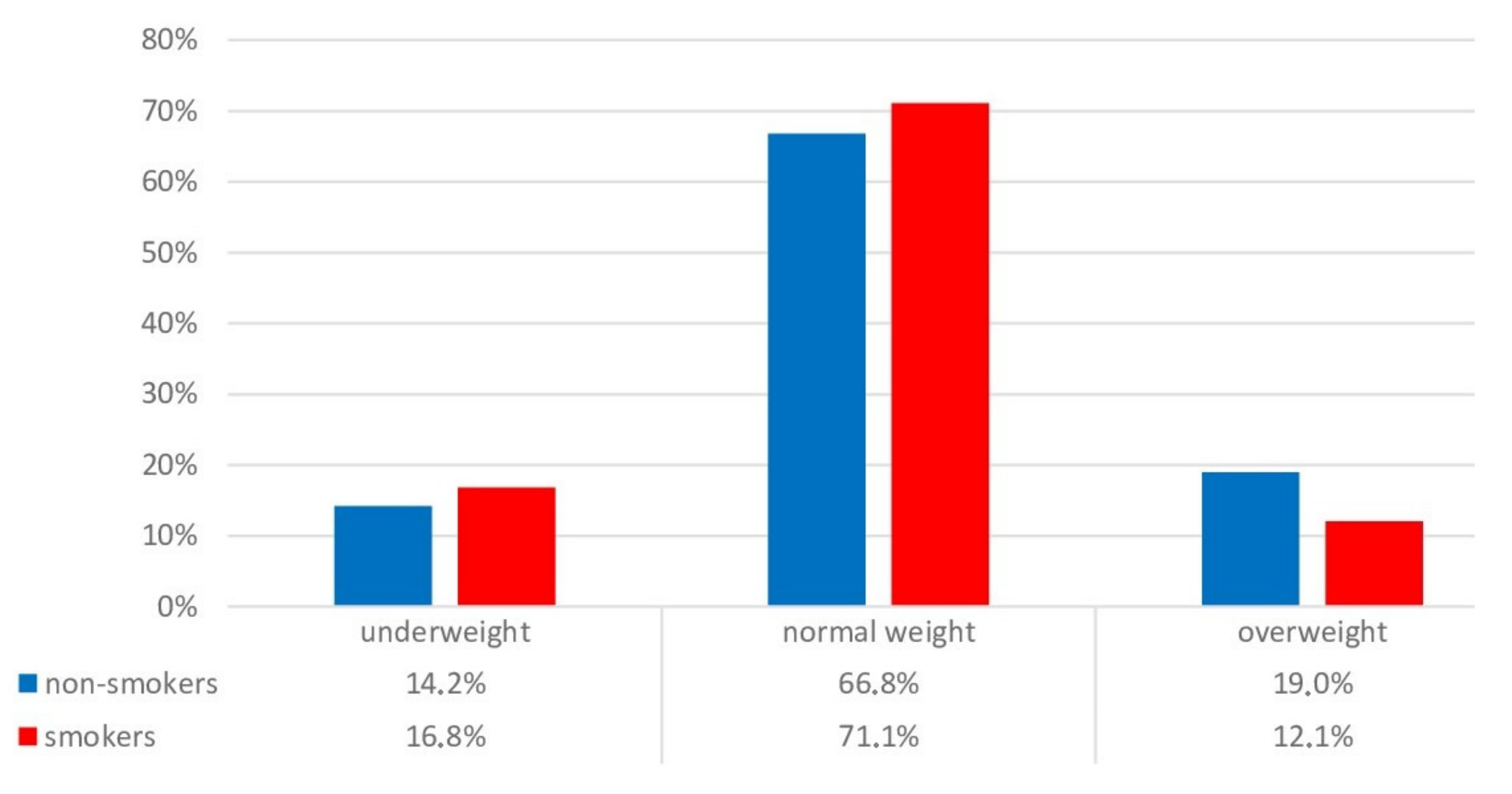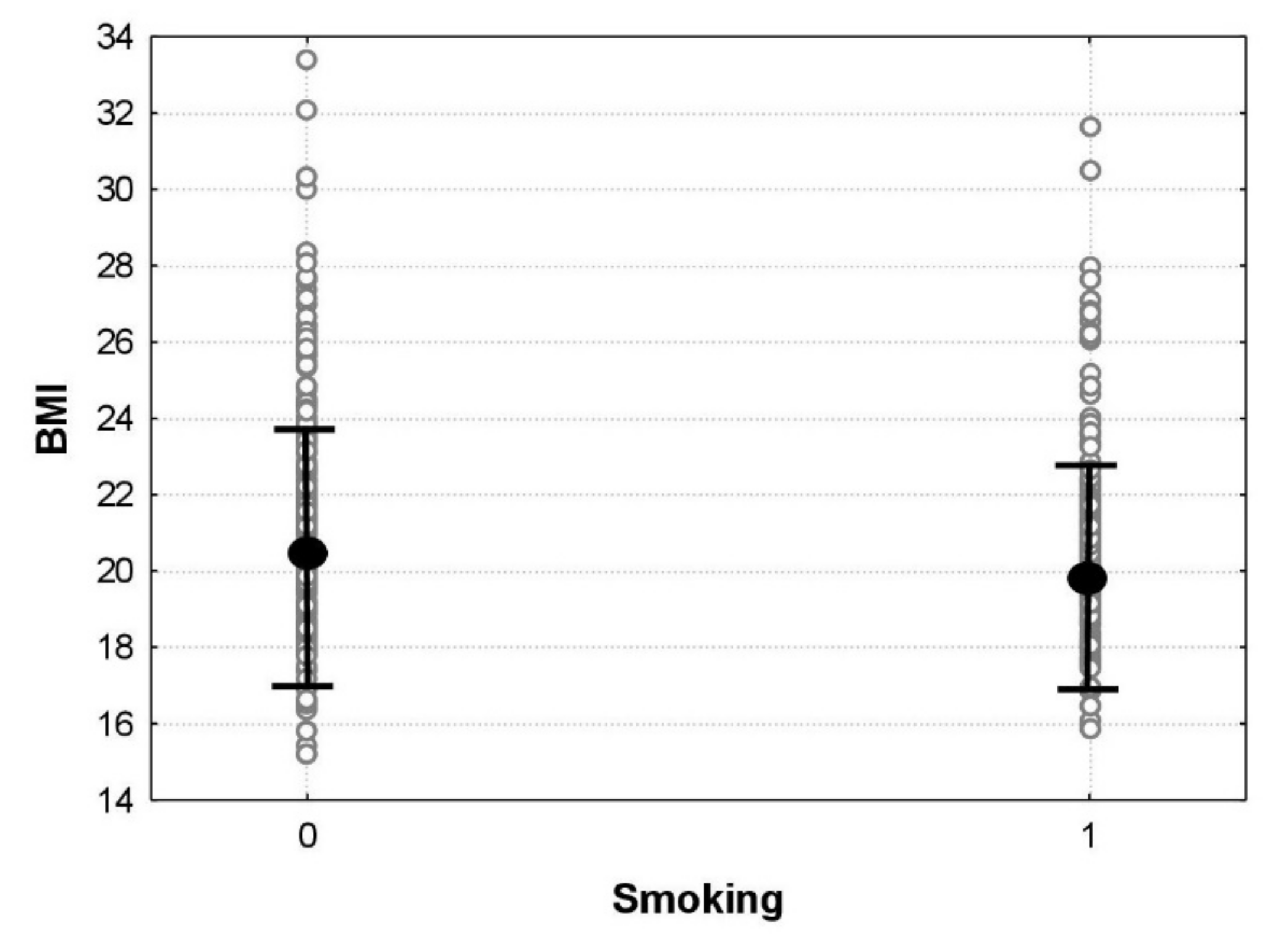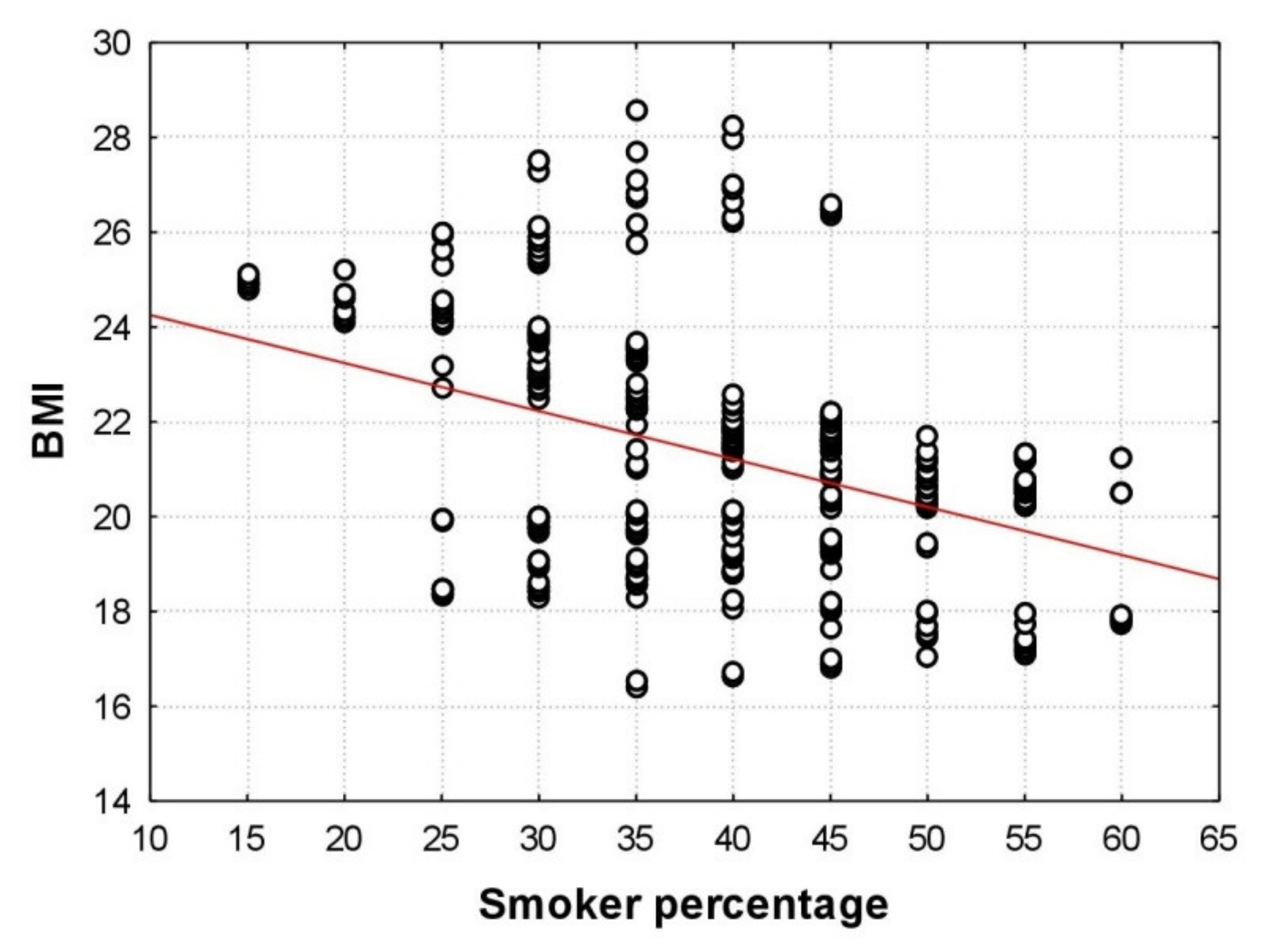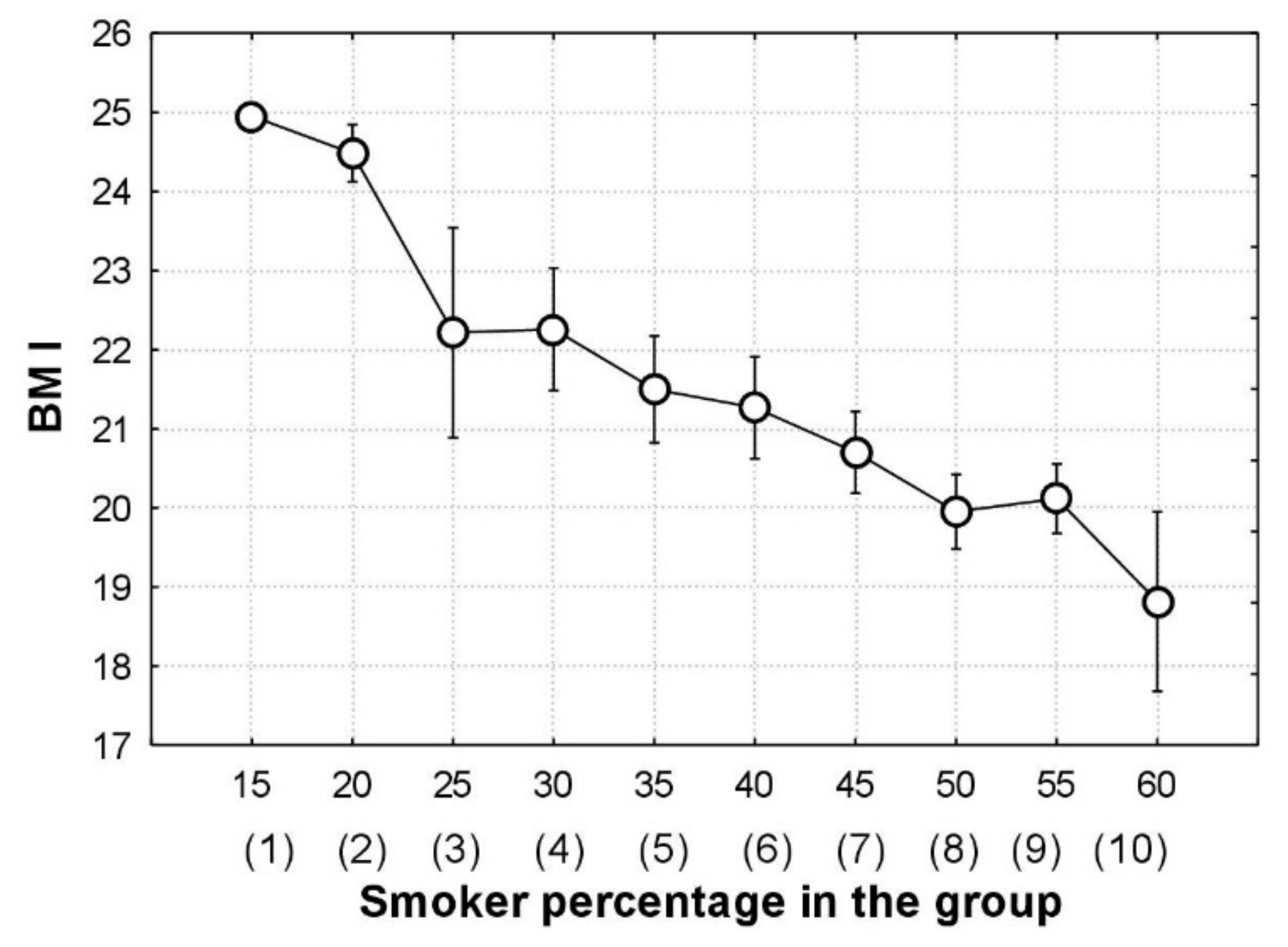An Analysis of the Links between Smoking and BMI in Adolescents: A Moving Average Approach to Establishing the Statistical Relationship between Quantitative and Dichotomous Variables
Abstract
:1. Introduction
2. Materials and Methods
2.1. Design of the Study
2.2. Sample Population
2.3. Measurements
2.4. Questionnaires
2.5. Statistical Analysis
2.6. Quantitative Outcome and Dichotomous Predictor
3. Results
3.1. Sample Characteristics
3.2. The Moving Average Approach and t-Test: Links between Smoking and BMI
4. Discussion
Limitations and Strengths
5. Conclusions
Author Contributions
Funding
Institutional Review Board Statement
Informed Consent Statement
Data Availability Statement
Acknowledgments
Conflicts of Interest
References
- Sahoo, K.; Sahoo, B.; Choudhury, A.K.; Sofi, N.Y.; Kumar, R.; Bhadoria, A.S. Childhood obesity: Causes and consequences. J. Fam. Med. Prim. Care 2015, 4, 187–192. [Google Scholar]
- WHO. Obesity and Overweight. Available online: http://www.who.int/mediacentre/factsheets/fs311/en/ (accessed on 6 September 2021).
- Bilano, V.; Gilmour, S.; Moffiet, T.; d’Espaignet, E.T.; Stevens, G.A.; Commar, A.; Tuyl, F.; Hudson, I.; Shibuya, K. Global trends and projections for tobacco use, 1990–2025: An analysis of smoking indicators from the WHO Comprehensive Information Systems for Tobacco Control. Lancet 2015, 385, 966–976. [Google Scholar] [CrossRef]
- Badicu, G.; Zamani Sani, S.H.; Fathirezaie, Z. Predicting tobacco and alcohol consumption based on Physical Activity Level and demographic characteristics in Romanian students. Children 2020, 7, 71. [Google Scholar] [CrossRef] [PubMed]
- Haffner, S.; Taegtmeyer, H. Epidemic obesity and the metabolic syndrome. Circulation 2003, 108, 1541–1545. [Google Scholar] [CrossRef] [Green Version]
- Carayanni, V.; Vlachopapadopoulou, E.; Koutsouki, D.; Bogdanis, G.C.; Psaltopoulou, T.; Manios, Y.; Karachaliou, F.; Hatzakis, A.; Michalacos, S. Effects of nutrition, and physical activity habits and perceptions on Body Mass Index (BMI) in children aged 12–15 years: A cross-sectional study comparing boys and girls. Children 2021, 8, 277. [Google Scholar] [CrossRef]
- Nédó, E.; Paulik, E. Association of smoking, physical activity, and dietary habits with socioeconomic variables: A cross-sectional study in adults on both sides of the Hungarian-Romanian border. BMC Public Health 2012, 12, 60. [Google Scholar] [CrossRef] [PubMed] [Green Version]
- Centers for Disease Control and Prevention. Childhood Obesity Causes & Consequences. 2016. Available online: https://www.cdc.gov/obesity/childhood/causes.html (accessed on 20 December 2021).
- Centers for Disease Control and Prevention. Adult Obesity Causes & Consequences. 2017. Available online: https://www.cdc.gov/obesity/adult/causes.html (accessed on 20 December 2021).
- Sundquist, J.; Johansson, S.E. The influence of socioeconomic status, ethnicity and lifestyle on body mass index in a longitudinal study. Int. J. Epidemiol. 1998, 27, 57–63. [Google Scholar] [CrossRef] [Green Version]
- Lahti-Koski, M.; Pietinen, P.; Heliövaara, M.; Vartiainen, E. Associations of body mass index and obesity with physical activity, food choices, alcohol intake, and smoking in the 1982–1997 FINRISK Studies. Am. J. Clin. Nutr. 2002, 75, 809–817. [Google Scholar] [CrossRef] [Green Version]
- Duvigneaud, N.; Wijndaele, K.; Matton, L.; Deriemaeker, P.; Philippaerts, R.; Lefevre, J.; Thomis, M.; Duquet, W. Socio-economic and lifestyle factors associated with overweight in Flemish adult men and women. BMC Public Health 2007, 7, 23. [Google Scholar] [CrossRef] [PubMed] [Green Version]
- Dowler, E. Inequalities in diet and physical activity in Europe. Public Health Nutr. 2001, 4, 701–709. [Google Scholar] [CrossRef] [PubMed] [Green Version]
- Johansson, L.; Thelle, D.S.; Solvoll, K.; Bjørneboe, G.E.; Drevon, C.A. Healthy dietary habits in relation to social determinants and lifestyle factors. Br. J. Nutr. 1999, 81, 211–220. [Google Scholar] [CrossRef] [Green Version]
- European Tobacco Trends Report 2019. Available online: https://www.euro.who.int/__data/assets/pdf_file/0006/413268/Tobacco-Trends-Report-RUS.pdf (accessed on 20 December 2021).
- Kim, Y.; Jeong, S.M.; Yoo, B.; Oh, B.; Kang, H.-C. Associations of smoking with overall obesity, and central obesity: A cross-sectional study from the Korea National Health and Nutrition Examination Survey (2010–2013). Epidemiol. Health 2016, 38, e2016020. [Google Scholar] [CrossRef] [Green Version]
- De Munter, J.S.; Tynelius, P.; Magnusson, C.; Rasmussen, F. Longitudinal analysis of lifestyle habits in relation to body mass index, onset of overweight and obesity: Results from a large population-based cohort in Sweden. Scand. J. Public Health 2015, 43, 236–245. [Google Scholar] [CrossRef]
- World Health Organization. Tobacco. 2021. Available online: https://www.who.int/news-room/fact-sheets/detail/tobacco (accessed on 20 December 2021).
- Health and Human Services Department (Ed.) Report of the Surgeon General: Preventing Tobacco Use among Youth and Young Adults; U.S. Government Printing Office: Washington, DC, USA, 2012.
- Carnevale, R.; Cammisotto, V.; Pagano, F.; Nocella, C. Effects of smoking on oxidative stress and vascular function. In Smoking Prevention and Cessation; IntechOpen: London, UK, 2018. [Google Scholar]
- Smoking Problem among Young People. 2021. Available online: http://82.rospotrebnadzor.ru/directions/prava/145940/ (accessed on 20 December 2021).
- Chassin, L.; Presson, C.C.; Sherman, S.J.; Edwards, D.A. The natural history of cigarette smoking: Predicting young-adult smoking outcomes from adolescent smoking patterns. Health Psychol. 1990, 9, 701–716. [Google Scholar] [CrossRef]
- Marbin, J.N.; Gribben, V. Tobacco use as a health disparity: What can pediatric clinicians do? Children 2019, 6, 31. [Google Scholar] [CrossRef] [Green Version]
- Padrão, P.; Lunet, N.; Santos, A.C.; Barros, H. Smoking, alcohol, and dietary choices: Evidence from the Portuguese National Health Survey. BMC Public Health 2007, 7, 138. [Google Scholar] [CrossRef] [Green Version]
- Wilson, D.B.; Smith, B.N.; Speizer, I.S.; Bean, M.K.; Mitchell, K.S.; Uguy, L.S.; Fries, E.A. Differences in food intake and exercise by smoking status in adolescents. Prev. Med. 2005, 40, 872–879. [Google Scholar] [CrossRef]
- Larson, N.I.; Story, M.; Perry, C.L.; Neumark-Sztainer, D.; Hannan, P.J. Are diet and physical activity patterns related to cigarette smoking in adolescents? Findings from Project EAT. Prev. Chronic Dis. 2007, 4, A51. [Google Scholar]
- Cooper, T.V.; Klesges, R.C.; Robinson, L.A.; Zbikowski, S.M. A prospective evaluation of the relationships between smoking dosage and body mass index in an adolescent, biracial cohort. Addict. Behav. 2003, 28, 501–512. [Google Scholar] [CrossRef]
- Average, Median and Modal Level of Monetary Income of the Population in General in Russia and in the Constituent Entities of the Russian Federation. 2021. Available online: https://www.gks.ru/free_doc/new_site/population/bednost/tabl/tab-bed1-2-6.htm (accessed on 20 December 2021).
- WHO Child Growth Standards: Training Course on Child Growth Assessment. 2021. Available online: https://www.who.int/tools/growth-reference-data-for-5to19-years/indicators/bmi-for-age (accessed on 20 December 2021).
- WHO Report on the Global Tobacco Epidemic, 2017: Monitoring Tobacco Use and Prevention Policies; World Health Organization: Geneva, Switzerland, 2017; 263p, ISBN 978-92-4-151282-4.
- Tel, L.Z.; Dalenov, E.D.; Abduldaeva, A.A.; Koman, I.E. Nutritionology; LitTerra Publishing House: Moscow, Russia, 2017. [Google Scholar]
- Dietary Assessment: A Resource Guide to Method Selection and Application in Low Resource Settings. 2018. Available online: https://www.fao.org/3/i9940en/I9940EN.pdf (accessed on 20 December 2021).
- Mosteller, F.; Tukey, J. Data Analysis and Regression. A Second Course in Statistics; Addison-Wesley: Boston, MA, USA, 1977. [Google Scholar]
- Afifi, A.A.; Azen, S.P. Statistical Analysis: A Computer Oriented Approach; Academic Press: Cambridge, MA, USA, 1972. [Google Scholar]
- Hosmer, D.W.; Lemeshow, S. Applied Logistic Regression, 2nd ed.; John Wiley & Sons: Hoboken, NJ, USA, 2004. [Google Scholar]
- Shoukri, M.M.; Pause, C.A. Statistical Methods for Health Sciences; CRC Press: Boca Raton, FL, USA, 1999. [Google Scholar]
- Student. The probable error of a mean. Biometrika 1908, 6, 1–25. [Google Scholar] [CrossRef]
- Cessie, S.; Goeman, J.J.D.; Dekkers, O.M. Who is afraid of non-normal data? Choosing between parametric and non-parametric tests. Eur. J. Endocrinol. 2020, 182, 1–3. [Google Scholar] [CrossRef]
- Perkins, K.A.; Sexton, J.E.; DiMarco, A.; Fonte, C. Acute effects of tobacco smoking on hunger and eating in male and female smokers. Appetite 1994, 22, 149–158. [Google Scholar] [CrossRef] [PubMed]
- Li, Y.; Zhang, T.; Han, T.; Li, S.; Bazzano, L.; He, J.; Chen, W. Impact of cigarette smoking on the relationship between body mass index and insulin: Longitudinal observation from the Bogalusa Heart Study. Diabetes Obes. Metab. 2018, 20, 1578–1584. [Google Scholar] [CrossRef]
- Brockwell, P.J.; Davis, R.A. Introduction to Time Series and Forecasting, 3rd ed.; Springer International Publishing: Cham/Zug, Switzerland, 2016. [Google Scholar]
- Kalligeris, E.-N.; Karagrigoriou, A.; Parpoula, C. Periodic-type auto-regressive moving average modeling with covariates for time-series incidence data via changepoint detection. Stat. Methods Med. Res. 2020, 29, 1639–1649. [Google Scholar] [CrossRef]
- Cengiz, Ü.; Karahasan, M. A new statistical early outbreak detection method for biosurveillance and performance comparisons. Stat. Med. 2019, 38, 5236–5258. [Google Scholar] [CrossRef]
- Behboudi, M.; Farnoosh, R. Modified models and simulations for estimating dynamic functional connectivity in resting state functional magnetic resonance imaging. Stat. Med. 2020, 39, 1781–1800. [Google Scholar] [CrossRef]
- Botella-Rocamora, P.; López-Quílez, A.; Martinez-Beneito, M.A. Spatial moving average risk smoothing. Stat. Med. 2013, 32, 2595–2612. [Google Scholar] [CrossRef]
- Draper, N.R.; Smith, H. Applied Regression Analysis, 3rd ed.; John Wiley & Sons: Hoboken, NJ, USA, 2014. [Google Scholar]
- Siegel, A. Practical Business Statistics, 6th ed.; Academic Press: Cambridge, MA, USA, 2017. [Google Scholar]
- Frank, E.; Harrell, J. Regression Modeling Strategies: With Applications to Linear Models, Logistic and Ordinal Regression, and Survival Analysis; Springer: New York, NY, USA, 2015. [Google Scholar]
- Shalaumova, Y.V.; Varaksin, A.N.; Panov, V.G. A Program for Calculating a Moving Average and Checking the Applicability of Regression Models. Russian Patent No. 2019612871, 4 March 2019. [Google Scholar]
- Awad, A.; Obayan, A.; Salhab, S.; Roufayel, R.; Kadry, S. Effect of smoking on appetite, concentration and stress level. Glob. J. Health Sci. 2019, 12, 139. [Google Scholar] [CrossRef]
- Pavlos, P.; Vasilios, N.; Antonia, A.; Dimitrios, K.; Georgios, K.; Georgios, A. Evaluation of young smokers and non-smokers with Electrogustometry and Contact Endoscopy. BMC Ear Nose Throat Disord. 2009, 9, 9. [Google Scholar] [CrossRef] [Green Version]
- Skvortsova, E.U. The spread of and main motives for smoking among urban senior pupils in the Russian Federation in 2010–2011. Prev. Med. 2016, 1, 44–50. [Google Scholar] [CrossRef]
- Mohd Radzi, N.A.; Saub, R.; Mohd Yusof, Z.Y.; Dahlui, M.; Sujak, S.L. Nicotine dependence among adolescents single and dual cigarette users. Children 2021, 8, 144. [Google Scholar] [CrossRef]
- Strizhev, V.A. Monitoring of smoking among medical students. Kuban Sci. Med. Bull. 2014, 7, 64–70. [Google Scholar]
- Zenic, N.; Rezic, M.; Zovko, I.C.; Vlahovic, H.; Sattler, T. Does participation in sports influence the prevalence of and initiation into multiple substance misuse in adolescence? A two-year prospective analysis. Children 2020, 7, 109. [Google Scholar] [CrossRef]
- Preston, A.M. Cigarette smoking-nutritional implications. Prog. Food Nutr. Sci. 1991, 15, 183–217. [Google Scholar]
- Northrop-Clewes, C.A.; Thurnham, D.I. Monitoring micronutrients in cigarette smokers. Clin. Chim. Acta Int. J. Clin. Chem. 2007, 377, 14–38. [Google Scholar] [CrossRef]
- Gutiérrez-Pliego, L.E.; Camarillo-Romero, E.d.S.; Montenegro-Morales, L.P.; Garduño-García, J.d.J. Dietary patterns associated with body mass index (BMI) and lifestyle in Mexican adolescents. BMC Public Health 2016, 16, 1–7. [Google Scholar] [CrossRef] [PubMed] [Green Version]





| Variable | Non-Smokers (N1 = 226) | Smokers (N2 = 149) | |||||
|---|---|---|---|---|---|---|---|
| P25 | Median | P75 | P25 | Median | P75 | p-Value | |
| Consumption of main foods, grams a day | |||||||
| Cereals + beans | 29.3 | 89.3 | 196.3 | 0 | 54.6 | 142.8 | 0.002 |
| Beverages (juice, kompot) | 46.8 | 94.8 | 214.2 | 71.4 | 142.8 | 285.6 | 0.039 |
| Meat | 80.7 | 148.5 | 234.8 | 59.2 | 119.6 | 183.1 | 0.013 |
| Quark cheese | 0 | 2.2 | 12.3 | 0 | 0 | 7.1 | 0.006 |
| Cheese | 1.0 | 7.1 | 28.5 | 0 | 4.7 | 21.4 | 0.045 |
| Alcohol | 0 | 0 | 2.5 | 0 | 1.9 | 8.8 | <0.001 |
| Nutritional values | |||||||
| Proteins, % of energy value | 10.8 | 12.2 | 13.9 | 10.2 | 11.6 | 13.1 | 0.006 |
| Simple sugars, % of energy value | 22.2 | 27.2 | 31.4 | 24.5 | 28.9 | 33.4 | 0.007 |
| Carbohydrates, % of energy value | 43.9 | 51.1 | 58.1 | 46.0 | 52.9 | 60.1 | 0.026 |
| Cholesterol, g/day | 0.3 | 0.6 | 0.9 | 0.3 | 0.5 | 0.8 | 0.022 |
| Cholesterol/protein | 3.3 | 4.2 | 5.2 | 3.7 | 4.6 | 5.9 | 0.008 |
Publisher’s Note: MDPI stays neutral with regard to jurisdictional claims in published maps and institutional affiliations. |
© 2022 by the authors. Licensee MDPI, Basel, Switzerland. This article is an open access article distributed under the terms and conditions of the Creative Commons Attribution (CC BY) license (https://creativecommons.org/licenses/by/4.0/).
Share and Cite
Varaksin, A.N.; Konstantinova, E.D.; Maslakova, T.A.; Shalaumova, Y.V.; Nasybullina, G.M. An Analysis of the Links between Smoking and BMI in Adolescents: A Moving Average Approach to Establishing the Statistical Relationship between Quantitative and Dichotomous Variables. Children 2022, 9, 220. https://doi.org/10.3390/children9020220
Varaksin AN, Konstantinova ED, Maslakova TA, Shalaumova YV, Nasybullina GM. An Analysis of the Links between Smoking and BMI in Adolescents: A Moving Average Approach to Establishing the Statistical Relationship between Quantitative and Dichotomous Variables. Children. 2022; 9(2):220. https://doi.org/10.3390/children9020220
Chicago/Turabian StyleVaraksin, Anatoly N., Ekaterina D. Konstantinova, Tatiana A. Maslakova, Yulia V. Shalaumova, and Galia M. Nasybullina. 2022. "An Analysis of the Links between Smoking and BMI in Adolescents: A Moving Average Approach to Establishing the Statistical Relationship between Quantitative and Dichotomous Variables" Children 9, no. 2: 220. https://doi.org/10.3390/children9020220
APA StyleVaraksin, A. N., Konstantinova, E. D., Maslakova, T. A., Shalaumova, Y. V., & Nasybullina, G. M. (2022). An Analysis of the Links between Smoking and BMI in Adolescents: A Moving Average Approach to Establishing the Statistical Relationship between Quantitative and Dichotomous Variables. Children, 9(2), 220. https://doi.org/10.3390/children9020220







